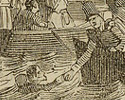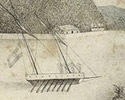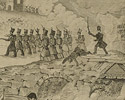19th Century´s militar history in the Basque Country
LUTXANA. 1836-XII-24
Following the second siege of Bilbao, which lasted a month and a half, its inhabitants found themselves in a precarious situation. Having survived the bombardments and lack of provisions caused by the blockade, they decided to pin their hopes on overseas aid.
 On the 22nd of December 1836, Espartero began manoeuvres near the bridge of Luchana. With the aid of two British Navy ships that carried out decisive bombardments, he launched the attack on the positions of the bridge of Luchana. On the 23rd, he managed to force his way across the river Galindo on a pontoon bridge he had constructed from small boats. However, his real target was the bridge of Luchana, which had been cut off by the Carlists and whose reconstruction was essential if the Liberal troops were to reach Bilbao.
On the 22nd of December 1836, Espartero began manoeuvres near the bridge of Luchana. With the aid of two British Navy ships that carried out decisive bombardments, he launched the attack on the positions of the bridge of Luchana. On the 23rd, he managed to force his way across the river Galindo on a pontoon bridge he had constructed from small boats. However, his real target was the bridge of Luchana, which had been cut off by the Carlists and whose reconstruction was essential if the Liberal troops were to reach Bilbao.
 In the afternoon of the 24th, again with the aid of the British Navy, the Liberals managed to take both ends of the bridge of Luchana with troops that had reached it in launches and barges. The most severe combats took place on Christmas Eve. The Liberal troops under General Oraa made a strenuous effort to take the two positions on the bridge of Luchana, but the Carlists managed to fend off all of their attacks.
In the afternoon of the 24th, again with the aid of the British Navy, the Liberals managed to take both ends of the bridge of Luchana with troops that had reached it in launches and barges. The most severe combats took place on Christmas Eve. The Liberal troops under General Oraa made a strenuous effort to take the two positions on the bridge of Luchana, but the Carlists managed to fend off all of their attacks.
 The overcast night and heavy snowfall made the task more difficult. Espartero himself led the Liberal attack, but the Carlists of Egia refused to give in. The soldiers on both fronts were exhausted. Then, Oraa told a bugler to call a retreat. But the latter, in error, called the forces to attack, which led to the Liberal victory. While the Carlists were ending the siege, Espartero was already entering Bilbao. The Liberals celebrated the victory of Luchana all over Spain and Bilbao, became the icon of the Liberals for its steadfast resistance.
The overcast night and heavy snowfall made the task more difficult. Espartero himself led the Liberal attack, but the Carlists of Egia refused to give in. The soldiers on both fronts were exhausted. Then, Oraa told a bugler to call a retreat. But the latter, in error, called the forces to attack, which led to the Liberal victory. While the Carlists were ending the siege, Espartero was already entering Bilbao. The Liberals celebrated the victory of Luchana all over Spain and Bilbao, became the icon of the Liberals for its steadfast resistance.

